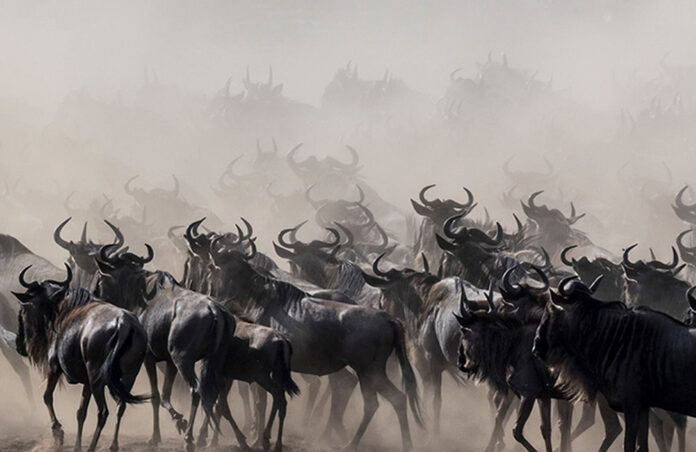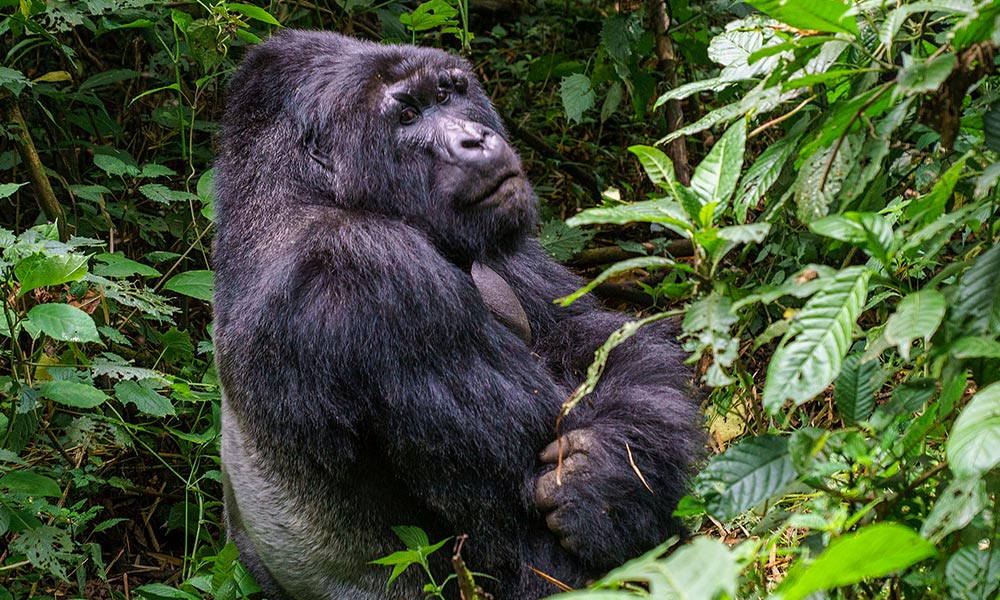Do you know the saying ‘the grass is always greener on the other side’? Well, during the great migration, the grass is indeed greener on the other side. Each year, over two million wildebeest, zebra and other herbivores trek from the southern Serengeti to the lush green grasses of the Masai Mara. Known as one of the seven wonders of the world, the great migration is an iconic safari must-see.
Highlights of the Great Migration
As the herds of wildebeest, zebras and gazelles enter the Masai Mara, they are met by more than their fair share of lethal predators. Aside from the threat of the big cats, the lemming-like herds are also faced with over 3000 crocodiles lurking in the murky waters of the Mara River during their river crossing. Watching the herds blindly jump from riverbank ledges and into the river waters is spectacular to say the least. Eventually the massive herds are rewarded with spoils of the wide open Masai Mara plains. For a short while, life is good. When the food supply dwindles and the rains move on, so do the herds.
Where do the wildebeest migrate to and from?
The movement of the wildebeest is from Serengeti into Masai Mara and is dictated by factors such as the climate, pasture and mating and calving seasons. Keep in mind the wildebeest are migrating through the year in a generally clockwise direction covering vast areas reaching into Southern, Central and Western Serengeti before the year long trek brings them to Masai Mara around July to August. Their journey back to Serengeti happens around late October though this is less spectacular and more like a slow dispersal.
How do you see the Wildebeest Migration?
You can see the migration during a safari game drive in the Masai Mara Game reserve which is conducted in specialized vehicles driver by experienced Driver-Guides. As there are several core points where the wildebeest cross the rivers, it may be necessary to access and station oneself at these points during a day-long outing in the reserve as some of the lodges and camps can be up to an hour’s drive from the ideal vantage points. Most tourists who come specially to see the migration consider seeing the river crossings a highlight of their tour and therefore want to spend enough time at these crossing points, which by the way tend to vary slightly every year while staying within a generally similar sub locality of the reserve.
What time of the year is the wildebeest Migration?
Though the migration into Masai Mara typically starts in July and ends late September, the exact dates around this period are not predictable until the first large wildebeest herds actually gather at the northern edge of Serengeti as they near the Mara. These initial herds are sometimes known to gather at a spot for days on end without crossing over to the Mara, so when exactly the final leg of the movement starts is difficult to predict.
What is the best time to visit Masai mara to see the Migration?
Based on decades of experience, we would choose mid-July to late August as the best time to see the migration, keeping in mind it is a gradual event that takes places over several weeks at different locations along the Serengeti Masai Mara border. If we were to narrow it down further to what month is the best to see the migration, we would probably pick August.
Is the river crossing in the Masai Mara guaranteed?
The animals can take days without crossing the river, hence it is possible to miss the crossing. For a better chance to witness the crossing, plan for a longer stay in the Mara, such as a week and there is a good chance you will see a crossing on the Mara River, or the smaller Tale River.
Month by Month Wildebeest Migration
Many people think that the Great Migration only happens once in a year, but the migration is in fact an all year round phenomenon event – offering different unique and exciting wildlife experience at various times of the year. The river crossing is one of the most requested events of the migration and usually coincide with the peak safari season, therefore the assumption that this is the only time of the year that the wildebeest are on the move or can be seen.
This crossing usually occurs at Mara River around late July to August with parts of September and again on their return south, around the last two weeks of October through early November. Hence, the best times to track and see the annual wildebeest migration in Masai Mara. Below is a general breakdown of more or less where the herds are during the year, bearing in mind it’s difficult to predict the herds movement as it’s prompted by rain, which can be early, late or ‘on time’.
December to April
Depending on the rains, the herds can be seen south of Serengeti National Park between Ndutu plains and Ngorongoro plains. Hence, the best place to be during these four months is the far south of Serengeti. Around February, it is the calving season and there are high chances of witnessing a wildebeest birth. The herds move swiftly, in search of favorable grasslands to provide sustenance for the arrival of their young. The predator interaction is also most likely, as the lions and leopards are moving to this region to prey on the young and vulnerable calves. End of March/early April the herds move slowly and predictably to begin their northward journey, and many have left already and are in the central and even western Serengeti.
May to June
During this time of the year the migratory herds all seem to be moving north, in search of fresh grazing and water. The migration is usually in huge columns of up to 40 kilometres / 25 miles in length can be sometimes be seen as the wildebeest funnel up into the central and western Serengeti, often containing hundreds of thousands of animals – joined by many zebras, and a scattering of Thomson’s and Grant’s gazelles. June marks the end of rainy season, traditionally this is the Grumeti River crossing period, but this is mainly dependent on water level of the Grumeti River. This crossing is not quite as spectacular as the crossings of the Mara River.
July to September
This is when the big event occurs, the start of major Mara River crossing. The herds have reached the western Serengeti and Grumeti Reserves and are peering closely at the brown waters of the rivers they have to cross. In August, the survivors herd continues moving northwards, into the northern Serengeti and begin crossing into Kenya’s Masai Mara National Reserve.
The herd breaks into smaller groups- almost half of the animals remain in the northern Serengeti, the rest of the wildebeest will have crossed the Mara River, and the majority of the herds will be in the Greater Masai Mara area, eating the lush green grass resources before venturing north towards the private conservancies. This is usually the most preferred moments of the migration, watching the frantic herds of the wildebeests crossing the Mara River.
October to November
The wildebeest herds are migrating again with more accord: all are heading south, through western Loliondo and the Serengeti National Park’s Lobo area, returning to the green shoots. The herds can now be seen in Kogatende and Lamai. In a ‘normal year’ the short rains have begun in November. The herds are now in the Serengeti, stationed in the Lobo, Mbuze Mawe and Seronera Valley areas where water is abundant. Fresh grazing sees the wildebeest clustered in the north-eastern Serengeti as well as the southern Serengeti. Calving begins again, the predators move in again, and the cycle of life begins all over again.
In conclusion
You will be able see the migration move through the Mara from day one of your entry in the park. W recommend spending at least two nights in the Mara for you to see and enjoy this spectacle of animals moving en masse through the plains. More nights also improve your chances of witnessing the epic river crossing.












